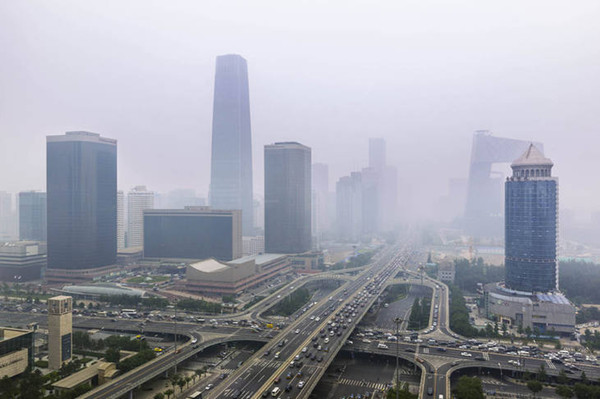China revs up air pollution control
 0 Comment(s)
0 Comment(s) Print
Print E-mail China Today, November 15, 2013
E-mail China Today, November 15, 2013
IN recent years, a thickening haze has been troubling Chinese people and foreigners living in many Chinese cities. In late 2012 and early 2013, most of the country was shrouded in unprecedented smog, and at its worst, the affected area covered 1.3 million square kilometers. The Beijing-Tianjin-Hebei area in the north is one of the most polluted areas in China. In Beijing, the center of this area, people saw only four days of fine weather in the whole of January 2013.
 |
|
Dense smog shrouds the Beijing cityscape on July 18, 2013. |
In urban areas, PM 2.5 (particulate matter with a diameter of 2.5 micrometers or less) is the chief culprit of the terrible climate. The fine particles are able to penetrate the cilia in the nose and pass directly to the lungs, adversely affecting human health. The entire nation is concerned about how to drive the haze away, and the Chinese government is accelerating its response to the crisis.
At the end of last year, the government issued the 12th Five-year Plan on Air Pollution Prevention and Control in Key Areas, and in June 2013, the Ten Measures on Air Pollution Control. On September 12, it officially implemented the Action Plan on Air Pollution Prevention and Control with much stricter standards, higher goals, and more stringent measures.
From Five-year Plan to Action Plan: Higher Goals
The 12th Five-year Plan on Air Pollution Prevention and Control in Key Areas issued by the Ministry of Environmental Protection at the end of 2012 was the first comprehensive program in this regard. The document put forward that by 2015, the annual concentration of inhalable particles and fine particles in the worst affected areas would decrease by 10 and five percent respectively. The plan involved 47 cities, including four municipalities directly under the central government and 15 provincial capitals.
However, the prolonged bout of heavy pollution that descended in late 2012 and early 2013, which foreign media dubbed the “Airpocalypse,” forced the government to take much stricter measures to tackle the problem. At a State Council meeting chaired by Premier Li Keqiang on June 14, 10 measures on air pollution control were outlined, including industrial readjustment, eliminating outdated production facilities, improving legal standards and coordinating prevention and control measures.
For PM 2.5 reduction in three key regions – Beijing-Tianjin-Hebei, the Yangtze River Delta and the Pearl River Delta – the Ten Measures put forward a higher goal compared with the 12th Five-year Plan. In particular, the Beijing-Tianjin-Hebei area is required to decrease PM 2.5 concentration by 25 percent by 2017. In addition, the Ten Measures attach greater importance to industrial air pollution abatement. The key is to eliminate outdated production capacity. Specific goals in this regard have been put forward for the steel, cement and glass industries. The government also promised to decrease atmospheric pollution emissions by over 30 percent in the key industries by 2017.
Chai Fahe, vice-president of the Chinese Research Academy of Environmental Sciences (CRAES), said the recently released Action Plan includes detailed measures of the 12th Five-year Plan and presents more specific targets and stringent measures than the Ten Measures adopted by the State Council.
Beijing-Tianjin-Hebei Faces Most Rigorous Control
The Action Plan pledges to improve the country’s air quality, substantially decrease the number of heavily polluted days, and markedly improve air quality in the three key areas over five years. The plan also promises to devote five years or longer to eliminating heavily polluted days, and improving air quality throughout the country.
The Action Plan entails more specific targets to be reached by 2017, compared with 2012: a decrease in inhalable particulate concentration in cities by 10 percent and gradual increase in days of fine weather; a decrease in fine particulate concentration by about 25, 20 and 15 percent for Beijing-Tianjin-Hebei, the Yangtze River Delta and the Pearl River Delta respectively; and in Beijing, a reduction of the annual concentration of PM 2.5 to under 60 micrograms per cubic meter. It is estimated that the Action Plan requires a total fund of RMB 1.75 trillion.
The Action Plan’s PM 2.5 control targets for the Beijing-Tianjin-Hebei area differ greatly from the Five-year Plan, which regulated that the annual PM 2.5 concentration should decrease by six percent by 2015 compared with 2010. The Action Plan proposes that the annual concentration should decrease by 25 percent by 2017, compared with 2012, about four times more than the previous target for the same length of time.
“These targets are very specific and detailed, which means the government has a heavy task ahead,” said Chai. “It shows that the government is concerned about public health, and is also reflecting on a more sustainable development path.”
What China lacks in oil reserves, it makes up for in coal. But the mass consumption of coal and coal-centered energy generation is the main reason for smog during the heating season. “The fundamental solution to air pollution is to optimize the structure of energy consumption,” said Meng Wei, president of CRAES and academician at the Chinese Academy of Engineering.
The Action Plan recommends that by 2017, coal should account for less than 65 percent of total energy consumption. In the three key areas, total coal consumption will realize negative growth: By 2017, coal-fired boilers should be replaced by boilers heated by natural gas, non-fossil energy consumption should increase by 13 percent, and clean coal technology should be employed.






Go to Forum >>0 Comment(s)